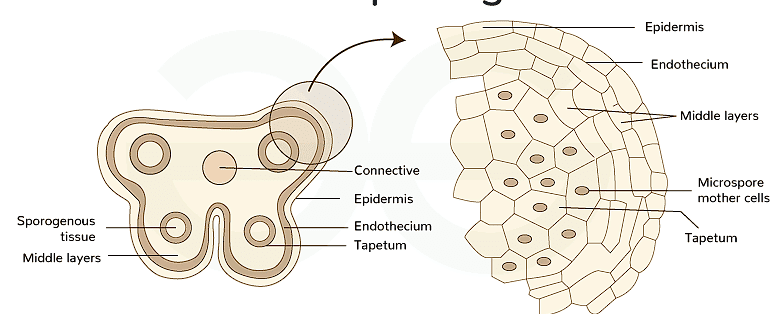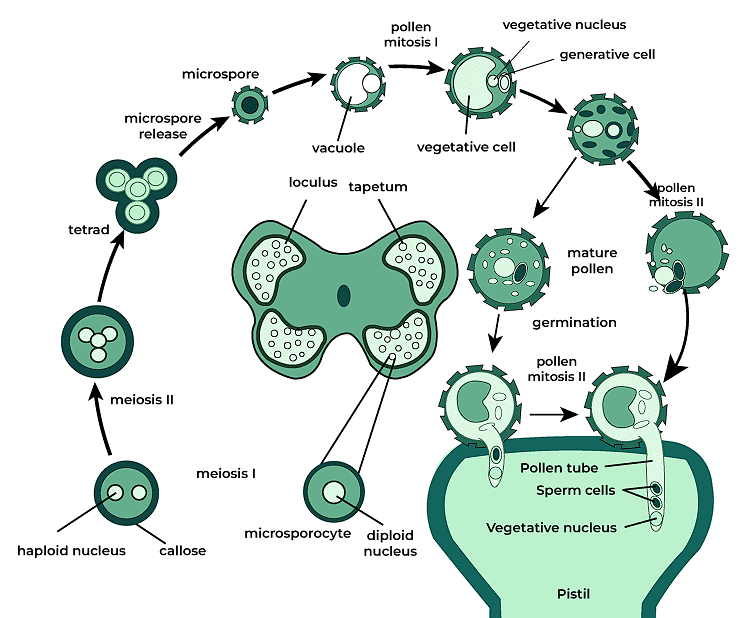Pollen Grain & Microsporogenesis | Biology Class 12 - NEET PDF Download
| Table of contents |

|
| What is Microsporangia? |

|
| Structure of Microsporangia |

|
| What is Microsporogenesis? |

|
| Structure and Development of Pollen Grain |

|
| Pollen Allergies |

|
| Pollen Viability |

|
Angiosperms, which are flowering plants, are heterosporous, meaning they produce two different types of spores: megaspores and microspores. These spores develop into male and female gametophytes, respectively. The microspores, which are produced in structures called microsporangia, develop into male gametophytes. These male gametophytes eventually mature into pollen grains, which are the male reproductive cells of the plant.
What is Microsporangia?
Microsporangia are tiny sac-like structures found in flowering plants that produce microspores

Microspores, develop into male gametophytes upon germination. In flowering plants (angiosperms), microsporangia are located within the anthers of flowers, while in gymnosperms, they are found in male cones. These male gametophytes, also known as pollen grains, contain sperm cells necessary for fertilization. During pollination, pollen is transferred to the stigma of the flower, ultimately leading to fertilization and seed formation.
Structure of Microsporangia
Microsporangia are structures with two lobes, resembling pollen sacs, located within the anther at the tip of the stamen, a slender structure in a plant. The microsporangium has a circular shape and is surrounded by four layers.
(i) The outermost layer, called the epidermal layer, is a single layer that stretches as the microsporangium matures and eventually falls off. Its main function is to shield the microspores.
(ii) Next is the endothecium, consisting of cells with fibrous endings and thickened cell walls. Along with the other three layers, it provides protection to the pollen and assists in the anther's splitting to release the pollen.
(iii) The middle layer is composed of 2-4 cells that break down as the microsporangium develops fully.
(iv) The tapetum, the fourth layer, comprises cells with dense cytoplasm and may contain one or more nuclei. The tapetum serves the crucial role of nourishing the pollen and aiding in the formation of the pollen wall.
Overall, the outer three layers safeguard the pollen and aid in the anther's opening to release the pollen, while the tapetum provides nourishment to the pollen grain.
What is Microsporogenesis?
Microsporogenesis is a vital process in plant reproduction, specifically in the formation of male reproductive cells called microspores. It occurs within specialized structures called pollen sacs, found within the anthers of flowers.

The process of microsporogensis is as follows:
- Microsporocyte: The process begins with a diploid cell known as a microsporocyte or pollen mother cell. These cells are located within the microsporangium, which is part of the anther.
- Sporogenous cells: The microsporocytes undergo meiotic division, a type of cell division that reduces the chromosome number by half. This division results in the formation of haploid cells called sporogenous cells.
- Microspore tetrads: The sporogenous cells further divide through meiosis to produce microspore tetrads, which consist of four haploid microspores. These microspores are enclosed within a protective wall.
- Microspores: Each microspore within the tetrad is now a haploid cell, ready to develop into a male gametophyte (Pollen Grain)
Structure and Development of Pollen Grain
Pollen grains, which serve as the male gametophytes in plants, are typically spherical and measure about 25-50 micrometers in diameter. They have a tough outer layer called the exine, composed of sporopollenin, an extremely resistant organic material that can withstand high temperatures and strong acids and alkalis. This exine layer contains germ pores, areas where sporopollenin is absent, and these pores are essential for pollen grain germination.
 Structure of a Pollen GrainPollen grains are well-preserved in fossils due to the presence of sporopollenin. Inside the exine layer lies the intine, a thin and continuous layer made of cellulose and pectin. The cytoplasm of the pollen grain is surrounded by a plasma membrane.
Structure of a Pollen GrainPollen grains are well-preserved in fossils due to the presence of sporopollenin. Inside the exine layer lies the intine, a thin and continuous layer made of cellulose and pectin. The cytoplasm of the pollen grain is surrounded by a plasma membrane.
When mature, the pollen grain contains two cells: the larger vegetative cell, which stores abundant food reserves and has a large nucleus, and the smaller generative cell, which floats within the cytoplasm of the vegetative cell. The generative cell is spindle-shaped with dense cytoplasm and its own nucleus.
 Development of microspore into pollen grain
Development of microspore into pollen grain
In many angiosperms, pollen grains are shed in this two-celled stage. In others, the generative cell undergoes mitotic division to produce two male gametes before the pollen grains are shed, resulting in a three-celled stage.
Pollen Allergies
Pollen from different plants can cause serious allergies and breathing problems for some people, like asthma or bronchitis. Parthenium, also called carrot grass, is widespread in India and a common trigger for pollen allergies.
Even though pollen can cause allergies, it's also packed with nutrients, so it's become popular as a food supplement, often sold as tablets. In places like the West, you can find lots of pollen products in stores, like tablets and syrups. Some people believe that eating pollen can improve the performance of athletes and racehorses.
Pollen Viability
Once pollen grains are released, they need to land on a flower's stigma quickly to stay useful for fertilization. How long pollen stays viable varies a lot, depending on things like temperature and humidity. For instance, pollen from grains like rice and wheat loses its viability within just 30 minutes, but some plant families' pollen, like Rosaceae, Leguminoseae, and Solanaceae, can stay good for months.

Just like how we store semen or sperm for artificial insemination, we can store pollen grains for a long time, even years, using a method called cryopreservation in really cold temperatures, like liquid nitrogen (-196°C). These stored pollen grains can be kept in pollen banks and used later in crop breeding programs, kind of like how we have seed banks.
|
88 videos|387 docs|202 tests
|
FAQs on Pollen Grain & Microsporogenesis - Biology Class 12 - NEET
| 1. What are microsporangia and their role in plant reproduction? |  |
| 2. What is microsporogenesis and how does it occur? |  |
| 3. What is the structure of a pollen grain? |  |
| 4. How do pollen allergies develop, and what are their symptoms? |  |
| 5. What factors influence pollen viability and germination? |  |





















